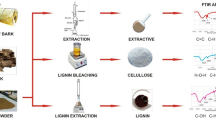Abstract
Unmodified lignin from sugarcane bagasse was chemically modified by acetylation, epoxidation and hydroxymethylation reactions. Modifications in lignin structure were characterized by FT-IR, 1H and 13C NMR spectra. The optimum reaction times for both epoxidation and hydroxymethylation of lignin were found to be 3 h by epoxy content and functional analysis, respectively. Acetylated and epoxy lignins were found to have lower DPPH radical scavenging activity [radical scavenging index (RSI) 0.15 and 0.16] than unmodified lignin (RSI 2.63), whereas hydroxymethyl derivative exhibited comparable activity (RSI 2.70) to unmodified lignin. Lignin and hydroxymethyl lignin were found to be more effective antioxidant than standard 3,5-di-tert-butyl-4-hydroxytoluene all lignins were found to be less effective than standard 3-tert-butyl-4-hydroxyanisole. Epoxy lignin was found to be most effective antibacterial among modified lignins with minimum inhibitory concentrations of 90 and 200 µg/disc against Bacillus aryabhattai and Klebsiella sp., respectively. It was concluded that natural lignin isolated from sugarcane bagasse and chemically modified lignins may be used as potential antioxidants and antibacterials.



Similar content being viewed by others
References
Anonymous. 1979. Methods of tests for epoxy resins, hardeners and epoxy resin compositions for floor topping. IS 9162-1979.
Catignani, G.L., and M.E. Carter. 1982. Antioxidant properties of lignin. Journal of Food Science 47: 1745–1748.
Chen, C.W., and C.T. Ho. 1995. Antioxidant properties of polyphenols extracted from green and black tea. Journal of Food Lipids 2: 35–46.
Davis, W.W., and T.R. Stout. 1971. Disc plate method of microbiological antibiotic assay. II. Novel procedure offering improved accuracy. Applied Microbiology 22 (4): 666–670.
Derin, C.Z. 2008. Synthesis and characterization of epoxy-acrylate vinylester resin and network structure. Ph.D. Dissertation. Middle East Technical University, Ankara, Turkey.
Dizhbite, T., G. Telysheva, V. Jurkjane, and U. Viesturs. 2004. Characterization of the radical scavenging activity of lignins-natural antioxidants. Bioresource Technology 95: 309–317.
Dong, X., M. Dong, Y. Lu, A. Turley, T. Jin, and C. Wu. 2011. Antimicrobial and antioxidant activities of lignin from residue of corn stover to ethanol production. Industrial Crops and Products 34: 1629–1634.
Gosselink, R.J.A., E. de Jong, B. Guran, and A. Abächerli. 2004. Co-ordination network for lignin-Standardisation, production and applications adapted to market requirements (EUROLIGNIN). Industrial Crops and Products 20: 121–129.
Kaplan, D.L. 1998. Biopolymers from renewable resources. Berlin: Springer.
Kaur, R., and S.K. Uppal. 2015. Structural characterization and antioxidant activity of lignin from sugarcane bagasse. Colloid and Polymer Science 293: 2585–2592.
Malutan, T., R. Nicu, and V.I. Popa. 2008. Contribution to the study of hydroxymethylation reaction of lignin. Bioresources 3: 13–20.
Pan, X., J.F. Kadla, K. Ehara, N. Gilkes, and J.N. Saddler. 2006. Organosolv ethanol lignin from hybrid poplar as a radical scavenger: Relationship between lignin structure, extraction conditions and antioxidant activity. Journal of Agricultural and Food Chemistry 54: 5806–5813.
Peng, F., J.L. Ren, F. Xu, J. Bian, P. Peng, and R.C. Sun. 2009. Comparative study of hemicelluloses obtained by graded ethanol precipitation from sugarcane bagasse. Journal of Agricultural and Food Chemistry 57: 6305–6317.
Stewart, D. 2008. Lignin as a base material for materials applications: Chemistry, application and economics. Industrial Crops and Products 27 (2): 202–207.
Sun, S.L., J.L. Wen, M.G. Ma, R.C. Sun, and G.L. Jones. 2014. Structural features and antioxidant activities of degraded lignins from steam exploded bamboo stem. Industrial Crops and Products 56: 128–136.
Acknowledgements
This study was partially supported by Maulana Azad National Fellowship by University Grants Commission, India, awarded to Ramandeep Kaur (MANF-2013-14-SIK-PUN-20159).
Author information
Authors and Affiliations
Corresponding author
Ethics declarations
Conflict of interest
The authors declare that they have no conflict of interest.
Rights and permissions
About this article
Cite this article
Kaur, R., Uppal, S.K. & Sharma, P. Antioxidant and Antibacterial Activities of Sugarcane Bagasse Lignin and Chemically Modified Lignins. Sugar Tech 19, 675–680 (2017). https://doi.org/10.1007/s12355-017-0513-y
Received:
Accepted:
Published:
Issue Date:
DOI: https://doi.org/10.1007/s12355-017-0513-y




